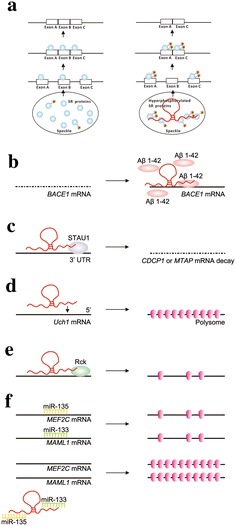Fig. 2.

A schematic diagram illustrating the involvement of lncRNAs in posttranscriptional processes. a lncRNA MALAT1 is implicated in pre-mRNA splicing. MALAT1 changes the expression and ratio of phosphorylated (orange circle with the letter “p”) versus dephosphorylated serine/arginine-rich (SR) proteins (splicing factors can regulate splicing; blue circle), thus altering the splicing mode of pre-mRNAs. b lncRNAs also influence mRNA stability. lncRNA BACE1-AS associates with cell stressor Aβ 1–42 and stabilizes BACE1 mRNA (dashed line represents unstable mRNA). c lncRNAs may cause mRNA decay. lncRNA 1/2-sbsRNA mediates mRNA decay by binding protein STAU1, with further base-pairing with an Alu element at the 3′-untranslated regions (3′-UTRs) of CDCP1 or MTAP mRNA (dashed line represents unstable mRNA). lncRNAs can serve as activators d or repressors e in mRNA translation. Antisense Uchl1 RNA associates mRNA with active polysomes, resulting in the promotion of translation. Conversely, lincRNA-p21 enhances interaction between translational repressor Rck and mRNAs such as CTNNB1 and JUNB, giving rise to polysome size reduction and translation repression. f lncRNAs also act as miRNA sponges, leading to derepression of miRNA targets. As indicated, lncRNA linc-MD1 “sponges” miR-133 and miR-135, antagonizing the miRNA-mediated translation suppression
